AP Calc AB - AP calc memorization flash cards
1/57
There's no tags or description
Looks like no tags are added yet.
Name | Mastery | Learn | Test | Matching | Spaced |
|---|
No study sessions yet.
58 Terms
Limit definition of a derivative
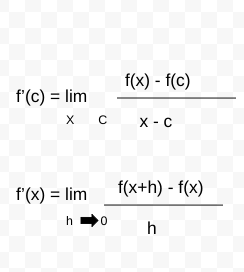
Intermediate Value Theorem (IVT)
If the function f(x) is continious on [a,b] and y is a number between f(a) and f(b) then there exists at least one number x = c in the open interval (a,b) such that f(c ) = y
![<p>If the function f(x) is continious on [a,b] and y is a number between f(a) and f(b) then there exists at least one number x = c in the open interval (a,b) such that f(c ) = y</p>](https://knowt-user-attachments.s3.amazonaws.com/e8065d8f-8a17-4c47-a59f-2f3146cc4b02.png)
Mean Value Theorem (MVT)
If the function f(x) is continuous on [a,b] AND the first derivative exists on the interval (a,b) then there is at least one number x = c in (a,b) such that f’(c ) = f(b) - f(a) / b - a
![<p>If the function f(x) is continuous on [a,b] AND the first derivative exists on the interval (a,b) then there is at least one number x = c in (a,b) such that f’(c ) = f(b) - f(a) / b - a</p>](https://knowt-user-attachments.s3.amazonaws.com/d11da148-0121-4a4c-80bc-20c13a2c8ec7.png)
Rolle’s Theorem
If the function f(x) is continuous on [a,b] AND the first derivative exists on the interval (a,b) AND f(a) = f(b) then there is at least one number x = c in (a,b) such that f’(c ) = 0
Extreme Value Theorem
If the function f(x) is continuous on [a,b], then the function is guaranteed to have an absolute maximum and an absolute minimum on the interval.
![<p>If the function f(x) is continuous on [a,b], then the function is guaranteed to have an absolute maximum and an absolute minimum on the interval.</p>](https://knowt-user-attachments.s3.amazonaws.com/81ce6478-2f39-4074-b20c-b035ffa50b8f.png)
d/dx (x^n)
nx^(n-1)
d/dx(sinx)
cos x
d/dx(cos x)
-sin(x)
d/dx(tanx)
sec²x
d/dx(cotx)
-csc²x
d/dx(sec x)
secx * tan x
d/dx (cscx)
-cscx * cotx
d/dx (ln u)
1/u * du/dx
d/dx(e^u)
e^u du/dx
chain rule

product rule

Quotient Rule

Derivative of an Inverse function
if f has an inverse function g then:
derivatives are reciprocal slopes

Implicit Differentiation
You will have dy/dx for each y in the original function or equation
Isolate the dy/dx
if taking second derivative d²y/dx², you will substitute expression you found for first derivative somewhere in the process
Average Rate of Change / AROC
f(b) - f(a) / b - a
Instantaneous Rate of Change / IROC

Curve Sketching an Analysis
y = f(x) must be continuous at each:
Critical Point: dy/dx = 0 or undefined
LOOK OUT FOR ENDPOINTS
Local minimum
dy/dx goes (- , 0, +) or (-, und, +) or d²y/dx²>0
Local Maximum
dy/dx goes (+,0,-) or (+,und,-) or d²y/dx²<0
Point of Inflection: concavity changes
d²y/dx² goes from (+,0,-), (-,0,+), (+,und,-) OR, (-,und+)
First Derivavtive
f’(x) > 0 function is increasing
f'(x) < 0 function is decreasing
f’(x) = 0 or DNE: Critical Values at x
Relative Maximum: f’(x) = 0 or DNE and sign of f’(x) changes from + to -
Relative Minimum: f’(x) = 0 or DNE and sign of f’(x) changes from - to +
Absolute Max or Min - MUST CHECK ENDPOINTS ALSO:
the maximum value is a y-value
Second Derivative
f’’(x) > 0 function is concave up
f’’(x) < 0 function is concave down
f’(x) = 0 and sign of f’’(x) changes, then there is a point of inflection at x
Relative Maximum: f’’(x) < 0
Relative Minimum: f’’(x) > 0
Write the equation of a tangent line at a point:
You need a slope (derivative) and a point
y2 - y1 = m(x2-x1)
Horizontal Asymptotes
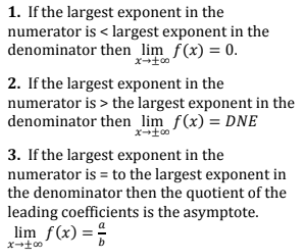
ONLY FOUR THINGS THAT YOU CAN DO ON A CALCULATOR THAT NEEDS NO WORK SHOWN
Graphing a function within an arbitrary view window
finding the zeros of a function
computing the derivative of a function numerically
computing the definite integral of a function numerically
Distance, Velocity, and Acceleration
x(t) = position function
v(t) = velocity function
a(t) = acceleration function
Speed is |velocity|
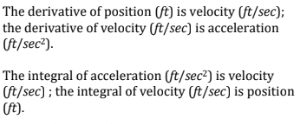
Displacement

Total Distance

average velocity

accumulation

Logarithms Definitions
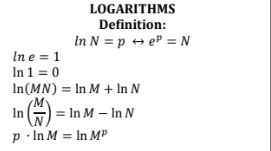
Exponential Growth and Decay
When Solving a differential equation:
seperate variables first
integrate
add +C to one side
Use initial conditions to find “C”
Write the equation in the form y = f(x)

Fundamental Theorem of Calculus

Corallary to FTC

Average Value
If the function f(X) is continuous on [a,b] and the first derivative exists on the interval (a,b) then there exists a number x = c on (a,b) such that favg= 1/(b-a) intab f(x)dx = intabf(x)dx/b-a
This value f(c ) is the “average value” of the ifunction on the integral [a,b]
![<p>If the function f(X) is continuous on [a,b] and the first derivative exists on the interval (a,b) then there exists a number x = c on (a,b) such that f<sub>avg</sub>= 1/(b-a) int<sub>a</sub><sup>b</sup> f(x)dx = int<sub>a</sub><sup>b</sup>f(x)dx/b-a</p><p>This value f(c ) is the “average value” of the ifunction on the integral [a,b]</p>](https://knowt-user-attachments.s3.amazonaws.com/89a5a1d9-6d7c-4a8d-aa4a-cbd6f4890829.png)
Riemann Sums
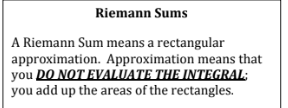
Sin(0) Cos(0) tan(0)
0, 1, 0
sin(pi/6), cos(pi/6), tan(pi/6)
1/2, sqrt(3)/2, sqrt(3)/3
sin(pi/4), cos(pi/4), tan(pi/4)
sqrt(2)/2, sqrt(2)/2, 1
sin(pi/3), cos(pi/3), tan(pi/3)
sqrt(3)/2, 1/2, sqrt(3)
sin(pi/2), cos(pi/2), tan(pi/2)
1, 0, infinite
sin(pi), cos(pi), tan(pi)
0, -1, 0
Area of cross section for squares

area between equilateral triangles

area between isosceles right triangles

area between curves rectangles

area between semi-circles

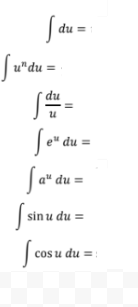
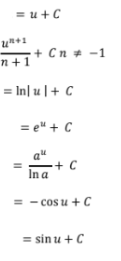
volume by washer method - about y and x axis

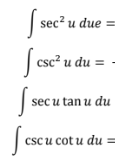

Area Between Two Curves

volume by disk method

volume by washer method






